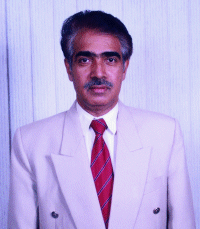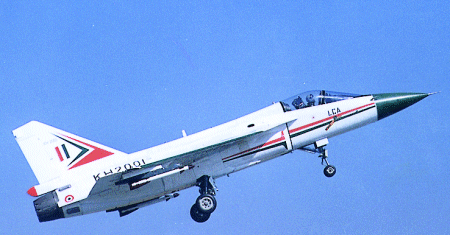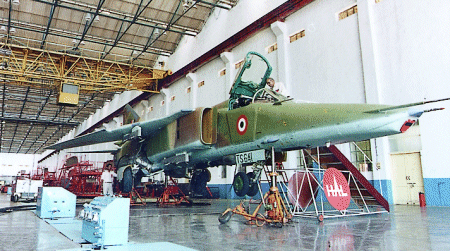With Aero India 2001 set to take place in Bangalore on 7-11 February, Hindustan Aeronautics is changing strategy
Chris Jasper/BANGALORE
With Indian defence commitments showing little sign of declining, state aerospace manufacturer Hindustan Aeronautics might be forgiven for planning a future strategy based around the offset work which has served it so well in the past. Licensed production of foreign aircraft types - together with the upgrade programmes needed to keep the aircraft effective - has long been the mainstay of HAL's workload, giving it a firm base from which to develop indigenous aircraft of various applications, again for the home military market.
Yet HAL plans to abandon this established way of doing business, with the aim of moving away from reliance on government programmes, deepening its civil manufacturing capabilities and - most importantly - entering into future programmes only on a "co-production" basis. Moreover, as a co-producer, state-owned HAL aims to become a risk-sharing partner in projects wherever possible, moving its operations onto another level from that of "servant of the Indian Government" - in the hope of ensuring its survival as a genuine player in the rapidly evolving aerospace sector.
Whether the Bangalore-based company will succeed in its aims depends, ultimately, on whether it is taken seriously as a prospective partner by other, largely Western, manufacturers. But HAL believes it is, at the very least, able to offer attractive technologies more advanced than those generally available in Asian countries, many developed in the face of sanctions imposed on India in the wake of its nuclear testing at Pokhran in May 1998.
Repositioning the business
HAL chairman Dr Krishnadas Nair accepts that moving away from simple buyer-seller relationships and repositioning the business will be a tough task. The move could also spell the end for fully indigenous Indian aircraft manufacture. HAL employs 34,000 people across India, and has produced 14 indigenous types (trainers, helicopters and fighters) since 1940.

"Our focus now is on partnership," he says. "We have been a licence manufacturer for a long time, designing and developing aircraft on our own, and we also have some subcontractor experience with Boeing, Airbus and BAE Systems. But our focus now is on a larger co-production partnership - whether we produce some parts and then licence build the aircraft, make an Indian-designed aircraft with a partner, or fully produce a foreign aircraft in India - such as the ATR 42 turboprop."
Nair says that co-production is also desirable in that it would see HAL establish itself as a manufacturer of lucrative sub-systems for foreign partners, rather than as a supplier of components. "We want to be doing assemblies and sub-assemblies," he says.
HAL already has well-established competencies across several fields, and although these may not be unique, the relatively low cost of being based in India means the company is extremely competitive on price, especially in areas such as design. "If we [India] are going to choose an aircraft from outside, we will have co-production and design, meaning joint design and development," says Nair. "We are cheaper and we can do it jointly with a US or European partner, whose investment in R&D will be less."
One HAL source says the post-Pokhran sanctions may be "a blessing in disguise", in that they have forced the company to develop competencies that it would not otherwise have had. Among its indigenous technologies are its Autolay autoclave, a Computational Fluid Dynamics (CFD) tool for wing and fuselage design, undercarriage capabilities and a fly-by-wire flight controls system, the latter developed when Lockheed Martin was forced to abandon a deal to supply its systems to HAL.
Nair hopes that two civil programmes - the ATR 42/72 and the Airbus A380 - will spearhead HAL's new strategy. HAL has signed a Heads Of Agreement with ATR (co-owned by EADS and Italy's Alenia) with the aim of establishing production of the 50- and 70-seaters in India for the home and foreign markets. Nair adds that although a possible Indian Airlines requirement for the type is central to the plan, the real aim is to cater to a far wider market.
Indian Airlines itself says it has studied proposals for regional turboprops, but is not yet convinced that they can be operated economically in India. Privately-owned Jet Airways already operates ATRs, however, and is taking more, convincing Nair that the type has a natural home in India.
"We have to look at the full market," he says. "In India there are potentially several airlines that will take turboprops, and the government has shown that it is willing to cut fuel tax for 50-seaters and below to encourage services to remote and rural destinations. So although the turboprop market may be on the decline in the West, it is at a stage where it may move up the curve in India, and then flatten out for some time before dipping. We are also looking at other Asian markets, such as China. "HAL and ATR have been talking for several years, however, without agreeing a final deal. Nair says it will not include ownership linkage.
HAL and ATR in talks
HAL's ambitions are best illustrated by its revelation of ongoing negotiations with Airbus for a stake in the A380 programme. HAL is keen to become a risk-sharing partner on the ultra-large airliner project, with a likely stake of 2-5%. He says the European manufacturer sent a team to India to assess HAL's manufacturing capabilities late last year, apparently with positive results. Nair will not put a price on the investment required, however. "The point is that this would be a risk-sharing deal," he says. "It would not in any way be linked to a possible purchase of the aircraft by an Indian carrier."
Strengthening HAL's case as it seeks civil partnerships is its current status as a subcontractor to both Airbus (for which it makes A320 doors) and Boeing (together with one of its major suppliers, Mitsubishi Heavy Industries of Japan). "These straightforward commercial relationships bring with them a certain confidence because they mean we are established as a trusted subcontractor," says Nair.

It is also likely that the co-production model will also be applied to HAL's flagship Light Combat Aircraft (LCA) which, after severe delays - which HAL largely blames on the impact of the 1998 sanctions - finally flew on 4 January. HAL sources suggest the company would like to recruit a full joint venture partner (rather than a supplier) to help produce the aircraft and its 18,100lb (80.5kN) Kaveri engine being developed by the Indian Defence Research Development Organisation's (DRDO) Gas Turbine Research centre.
Sources say HAL is open to the possibility of some aircraft being produced abroad, and to an engine alliance with a major aero-engine specialist. The Technical Demonstrator (TD) LCA that flew this month is powered by the GE F404-F2J3 engine, but the relationship with General Electric was a casualty of the post-Pokhran sanctions. The Kaveri is still undergoing ground and air tests - the latter on a Tupolev Tu-16 Badger bomber.
With the LCA having suffered so many delays, India is now keen to make up for lost time. A second flight by the TD-1 aircraft was expected last week, while TD-2 is due to fly in "June or July", according to Nair. A further three prototype vehicles are being built, with PV-1 apparently already being equipped almost to production standard but awaiting the fitting of weapons systems and a multi-mode radar. LCA programme director Dr Kota Harinarayana of the DRDO's Aeronautical Development Agency has said that a "concurrent engineering" approach will be adopted, with the aircraft essentially entering production before certification is fully complete.
The LCA is due to complete 1,500-2,000 flying hours before certification, but this could take five to seven years. The production process will instead begin after only 50-100h, in about two years. Although HAL is guarded about the timetable for the LCA to enter service, the first aircraft may be handed over to the Indian air force in four or five years. Final operational clearance is anticipated by around 2012.
Seeking an equipment partner
HAL already has a partner on another home-grown product, the Intermediate Jet Trainer IJT-36 (previously known as the Advanced Jet Trainer and as the HJT) tandem two-seat trainer and light attack aircraft, with France's Snecma having agreed to team on the powerplant, according to Nair. HAL now seeks an equipment partner on the aircraft, the prototype of which is due to fly in 2002, with certification in 2004 and production from 2005. The air force will require around 200 IJTs to replace its HAL Kirans, according to HAL. The aircraft would sit below the BAE Hawk, HALadds - an Indian order for which would therefore not affect the market for the IJT.

Another of HAL's indigenous projects, the Advanced Light Helicopter (ALH), is due to enter full production this year. Having first flown in 1992, Nair says the manufacturer is now "working to convert suppliers into partners by signing long-term agreements for the full project". Some 24 helicopters will be produced annually within two years, with the Indian air force, army and navy requiring around 300 and the Indian private sector around 50 more.
HAL had planned to add the Light Helicopter Turbine Engine Company's LHTEC T800 as an alternative powerplant for the ALH, but Nair says it "suffered a setback", and the aircraft will now be powered only by the TM333 from France's Turbomeca.
In addition to targeted vendors, HAL also hopes to convert design partner Eurocopter (now a wholly-owned EADS subsidiary) into a full partner. "We have had partners, like Eurocopter, who have acted as paid consultants - but now we want them to be both design and production partners," Nair says. "Instead of paying them a fee they will have a business interest. They are going to produce it, and they will have risk in it, which will be to our benefit."
HAL has a longstanding relationship with Eurocopter and its precursors via the licence-built Chetak and Cheetah helicopters (and the latter's new armed derivative, the Lancer), based on the Aerospatiale SA316B Alouette III and the SA315 Lama respectively. Eurocopter has long been reluctant to deepen its involvement with the ALH, however, and although HAL says the helicopter would fit into "a gap in their product range" there would appear to be some overlap. One of the ALH's key capabilities is a high altitude/heavy-lift ability developed to supply troops in Kashmir.
HAL's fourth major in-house project, the 100-seater tactical transport, was first mooted at the Aero India show in 1996, and is nearing project definition, with a detailed design expected to have been completed by April. Russia's Ilyushin has acted as the initial design partner after bids were solicited, but HAL is keen to secure a Western ally to take the aircraft further. "We are looking at a co-operative approach for design, development and production, with core manufacturing in India," says Nair. "Ilyushin was a contractor. We still want a partnership with the West on elements such as avionics."
HAL hopes to certificate the tactical transport by 2006, but with an Indian market estimated at less than 100 aircraft, Nair says "we will need to export it". He adds: "There is no direct competition, and we are looking at requirements in the West, plus Russia and Asian countries including China and Korea. We would want equipment and engine partners." Though HAL has advanced composites capabilities of its own, it says a partnership with Airbus Military - for example - could be beneficial from a marketing viewpoint. "We aim to have a large number of partners on the tactical transport, as we have on the IJT," Nair says.
Against this background of changing relationships, the importance of HAL's traditional business operations should not be forgotten. Production, under licence, of military types acquired by the Indian Government remains central to its business, as emphasised last month by New Delhi's finalised $3.3 billion deal for 140 licence-built Su-30MKI multirole fighters. The aircraft will be built by HAL over 15 years, as will the Lyulka Saturn AL-31FP engines, with thrust-vectoring nozzles.
Though licenced production generates more cash per unit for HAL than does indigenous production, yet saves the Indian Government money through lower local production costs, it amounts to little more than an exercise in the circulation of state funds (plus a hefty fee to Sukhoi for licencing and sub-assemblies) unless an export market is also involved.
The Su-30 order alone will see the ratio of licence-produced to homegrown aircraft rolling off the HAL production line increase from around 50 to 85 per 100 units, and more licence-built work is in the pipeline. India continues to mull its purchase of at least 66 Hawk advanced jet trainers, of which Nair says HAL "would either be a co- or licenced producer".
Upgrades mainstay
Upgrades are the other mainstay of HAL's output, and with the LCA not due to come fully onstream until next decade, several IAF types may need attention in the meantime. The air force's HAL (Mikoyan) MiG-21 Fishbeds, which will be replaced by some of the 200 LCA's destined for the air force, are already receiving a major weapons system and avionics upgrade to make them compatible with new missiles. Two have been upgraded in Russia and the rest are to be modified in India.

Nair also lists India's MiG-27Ms and -29s, HAL (Hawker Siddeley) HS748 surveillance platforms, HAL (Fairchild Dornier) 228MPA maritime patrol aircraft, Cheetah and Chetaks and HAL (Sepecat) Jaguars as aircraft that "will or could need upgrades", with work to be done "in conjunction with the manufacturer".
Some or all of the aircraft concerned, except the MiG-29s, were licence built in India, with the Jaguar still in production and HAL about to produce twin-seaters (17) for the first time.
HAL and India's smaller aerospace manufacturers have formed a lobby group - the Society of Indian Aerospace Technology and Industries - to further co-operation with major manufacturers and equipment suppliers, especially in Europe. The organisation has already held talks with its French and UK counterparts GIFAS and SBAC, and is due to do so with Israel and Italy.
Although the Indian manufacturing sector is aware that problems such as the various setbacks suffered by the LCA do little to advance its reputation overseas, a HAL source says that in pursuing a co-production strategy it at least has a degree of Western trust and goodwill on its side.
"In India we have a democracy and a judiciary, and although things may be slow, they will also be straight," says one source. "Any partner will get stability and legal reliability, and they won't necessarily get that in other countries. We are not like Malaysia or Indonesia, where a collaborator can very easily become a competitor."
The source cites the difficult teaming of Indonesia's IPTN (now Indonesian Aerospace) and Spain's CASA (now EADS) to produce the CN235 transport. "Indonesia would have competed with CASA had the collapse of its economy not stopped it," says the source. "And the Chinese civil aircraft industry could still become a major competitor to Airbus and Boeing. But HAL does not and will not follow that path. We are quite happy that our future is in genuine partnerships."
HAL reported sales of Rs2,400 crore in its 1999-2000 financial year ($555 million at adjusted rates), up 17% and ranking it 61st in the world and the largest Asian aerospace company outside Japan. Its pre-tax profit doubled to Rs415 crore (aided by land sales), giving it a high pre-tax profit margin of 17.3%. Last year aside, HAL's margins have been in single figures, rising year-on-year from 5% at the start of the 1990s to 9.66% in 1998-99. It expects its financial performance to improve only "marginally" during the current financial year, given a similar programme profile.
High military spending
However, while Nair says HAL is doing well, and that it is always guaranteed a future for as long as Indian military spending remains high, he also believes that it will "lose out eventually" should it fail to secure allies, and that the massive structural changes currently transforming the industry can only hasten this.
"Co-operation has become the norm, driven by the need for rationalisation because of the ever-growing complexity of the product, the greater financial risk and pressures on R&D (research and development) budgets," he says. "It makes sense for companies to get together to achieve economies of scale and to create value. We cannot all be doing all things, and co-operation means greater resources and skills and access to manufacturing and facilities."
Source: Flight International













